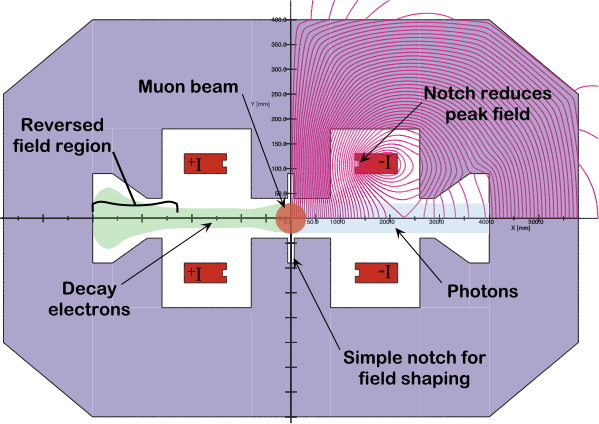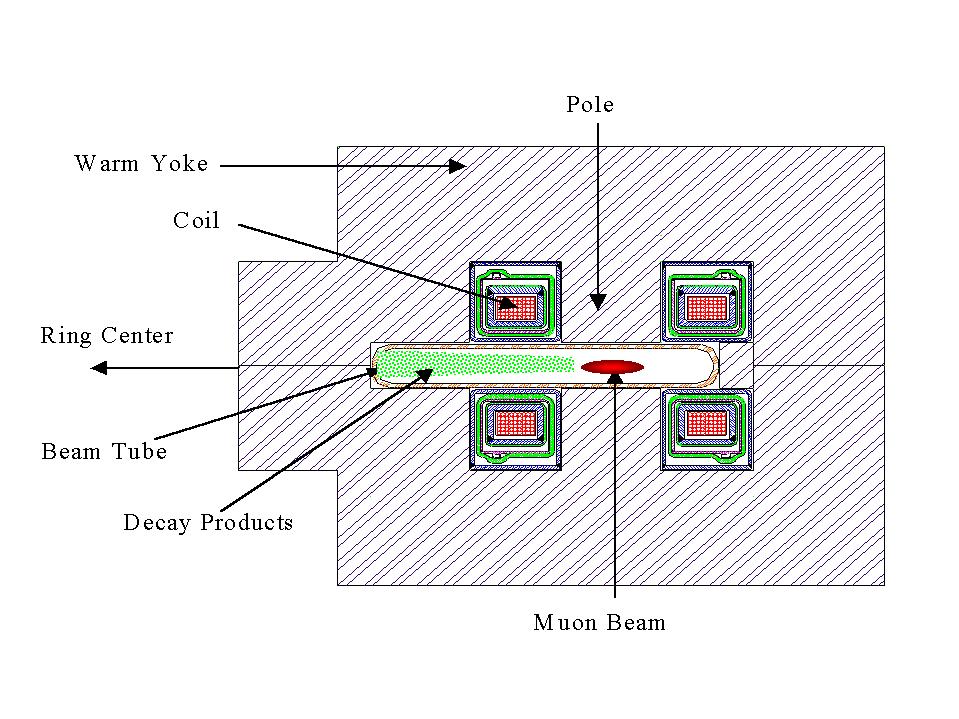Toy Model Dipole Design Considerations
The concept suggested by Mike Harrison for the muon storage ring magnet has:
- a pair of simple flat pancake coils
- in small independent cryostats
- with warm iron center pole and yoke
- kept open in the midplane for a horizontally extended beam pipe
- with the decay electrons either hitting a warm beam pipe that is well away from the superconducting coils
- or being channeled back by a region of reversed B-field
- so that most of the energy is deposited in warm sections either inside the magnet or in collimators outside the magnet.
At 5 T it is clear that the iron yoke is highly saturated and does not make a large contribution to the dipole's transfer function; however, the yoke can:
- provide a handle for field shaping near the pole
- and field control in the low and reversed field region outside the superconducting coils
- while containing stray flux
- and therefore adding to the transfer function
- and providing some protection from energy deposition for the superconductor.
When this magnet concept was directly implemented at 5 T, before paying attention to field uniformity, we quickly found that the dominate reason for particle loss was poor field uniformity. That is to say, if a significant fraction of the original muon beam hits the beam pipe, the decay electrons, with increased divergence and lower energy, will find the beam pipe even faster.
So the first critical step was to improve the field quality. For the toy model dipole magnet, run at fixed field, this is accomplished by taking a deep cut into the center of the pole. By varying the width and depth of the cut we quickly found an acceptable solution. A partial motivation for such a notch is that it might offer a convenient attachment point for supporting a vacuum beam pipe with poor height-to-width aspect ratio; however, for this study, adding a notch for field trimming is merely a convenient way to provide sufficient good field region.
For the toy model it is also convenient to only define one-quarter of the model and then use symmetry to reconstruct the material and field distributions for a full magnet. Such symmetry may not be needed if the energy deposition at the coils due to photons hitting the ring outside edge of the beam pipe is sufficiently small. An asymmetric design could then be used to reduce the yoke material needed.

Toy model dipole with improved field harmonics and extended vertical cutout
Field shaping might also be accomplished by changing the coil geometry. We find that for the 5 T excitation considered for the toy model dipole, small changes in coil geometry are not as effective as the pole cuts described above. This behavior might not continue to be valid if we were to try to push the design to even higher central fields, say 8.5 T. For fields much beyond 5 T the toy model NbTi superconductor would have to be replaced with NbSn or some other high field material. For the present toy model the coil shape was optimized to simultaneously reduce superconductor current density and peak field. This is achieved by slightly stretching the coil cross section horizontally and removing some of the conductor at high field points at the inner surface (as seen above). Since changes to the coil geometry do change the horizontal field distribution seen between the top and bottom pancake coils, such coil changes could in principle affect decay particle trapping; however, this effect is not explored further in the present study.
In the yoke cutout region, beyond the superconducting coil, we find that in a flat cutout the field again becomes uniform, vertical but opposite to the central field. For 5 T central field we find that the reversed field is clamped at about 1 T and is independent of the width of the cut (at least until the integrated reversed flux starts to approach in magnitude half the total flux in the pole). Too deep a cutout region will force the magnet yoke to be unattractively wide while too shallow a cut brings a region of potentially high energy deposition closer to the superconducting coil. So cutout dimensions are expected to be important optimization parameters.
In the early stages, before the toy model field quality was corrected, we found that many decay particles would hit the top or bottom beam pipe before they even got close to the inner beam pipe wall. Once the central field quality was improved, many of these top and bottom hits went away; nevertheless, in order to give the decay electrons their best chance to make it through the magnet, for the present toy model study the cutout region is vertically expanded (as shown above). With the present vertically expanded cutout we find a few particles, which would have hit an unexpanded beam pipe, do survive and are bent back to the low field region between the coils; however, these particles still end up hitting the top or bottom of the beam pipe (but this time closer to the coils). Perfecting the cutout shape is an exercise that we leave for future study. The point of the toy model study is to see if we can find at least one configuration for which trapping can be demonstrated.




